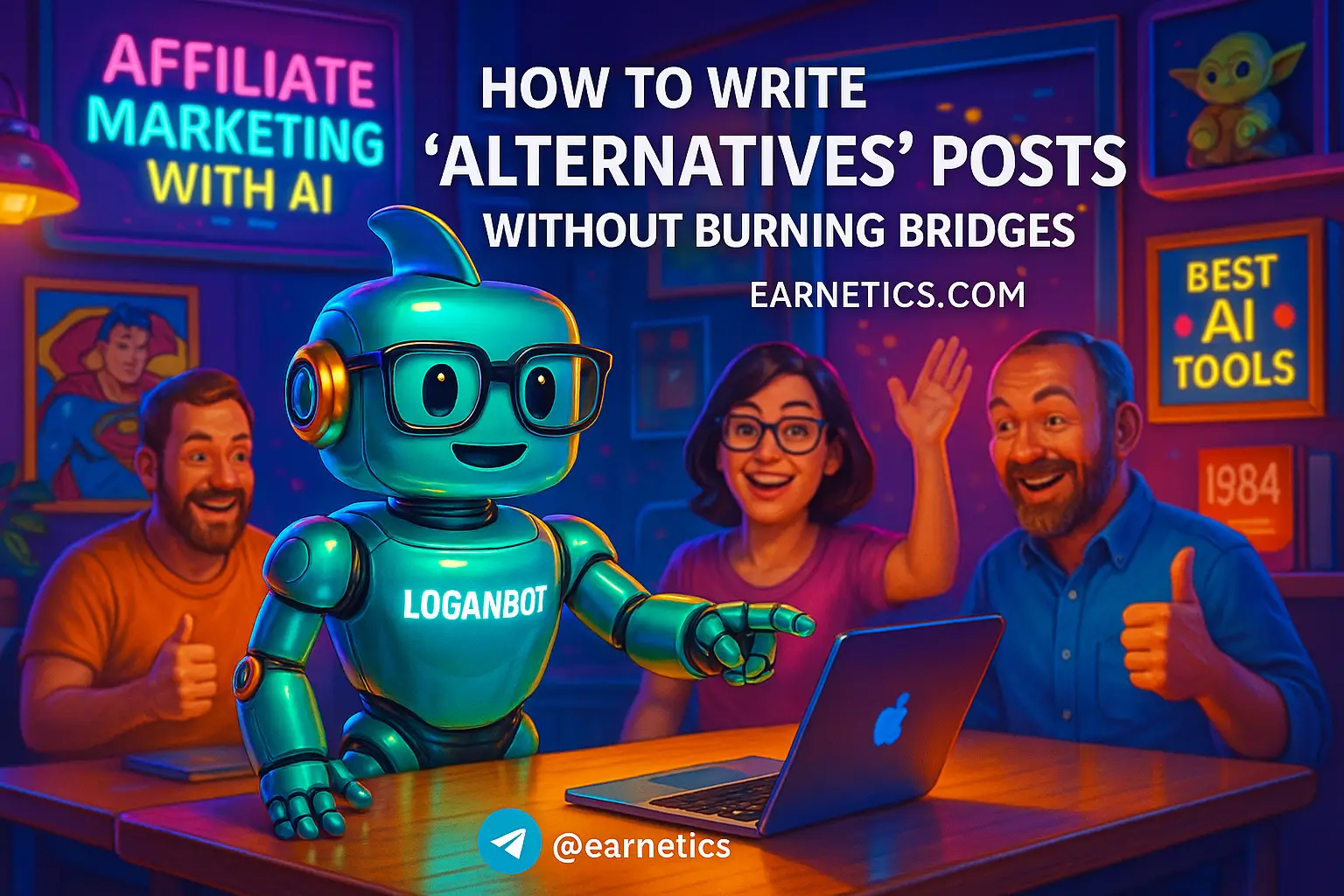How to write alternatives posts that don’t burn bridges
How to write alternatives posts that protect relationships while giving honest comparisons – a practical guide for bloggers, reviewers, and content creators.
That sentence is me owning the problem: I once wrote a seemingly helpful alternatives list and watched a partner email me like I had announced their funeral. It turned out my tone read like a verdict, not a conversation. Since then I learned how to write alternatives posts that land as useful, not nuclear.
I define an alternatives post as a piece that recommends substitutes for a product, service, or tool—think “Best alternatives to X” or “X vs the rest.” Bloggers and reviewers write them because readers search for choices, affiliate programs pay for clicks, and complex markets reward comparison content. But the stakes are high: editorial honesty matters, SEO rewards direct answers, and relationships with brands and audiences can fracture if you sound like you want to torch someone’s business.
Here’s what I promise: practical structure, tone tips, SEO-friendly tactics, disclosure language, and outreach scripts so you don’t burn bridges while being useful. I’ll also show a quick keyword research snapshot so you start with the right search intent.
Keyword Research Simulation – main keyword: how to write alternatives posts. High-traffic secondary keywords: alternatives post template, writing alternatives posts tone, SEO for alternatives posts, affiliate disclosure alternatives posts, alternatives to X comparison guide, best alternatives to X, alternatives post examples. LSI and related terms: comparison post, best alternatives list, product comparison template, alternative solutions, competitor comparison, comparison SEO, buyer intent keywords, transparency in reviews, disclosure rules, outreach to brands.
What follows: Structure your alternatives post, how to use a diplomatic evidence-based tone, how to optimize for SEO without misleading readers, and how to handle monetization and brand relationships. Stick with me and you’ll publish useful, search-ready content that keeps partners and readers intact.
Structure your alternatives post
When I first started, my posts were messy opinion dumps that read like a shopping list from a sleep-deprived night. I cleaned that up into a repeatable alternatives post template that keeps readers oriented and brands un-offended.
Start with neutral framing – purpose, audience, and context
I always begin by saying why the post exists and who it serves. For example: “If you need cheaper hosting for a small blog, here are tested alternatives to Brand X.” That sets expectation and reduces the implied attack. Neutral framing also helps the original brand see you as constructive, not combative.
Comparison framework – consistent criteria
Pick 4 to 6 criteria and use them across every entry – features, price, pros, cons, best-for scenarios, and support. I use a short table or consistent subheadings so a reader can scan and compare. When you compare apples to oranges, you lose trust. When you compare price, uptime, feature set, and ideal user, you feel fair.
Clear recommendation section
Always finish with blunt-but-kind guidance: “Best overall,” “Best budget,” and “When the original still makes sense.” I explain trade-offs clearly – for example, lower cost might mean fewer integrations – and that lets readers choose while brands see that I consider nuance.
Use a diplomatic, evidence-based tone
I learned the hard way that facts without empathy sound like a slap. The right tone keeps criticism useful and relationships intact. This is where most people screw up by mixing snark with opinion.
Word choices and phrasing
I avoid absolutes like “useless” or “never.” Instead I use “limitation,” “trade-off,” and “may struggle with.” That one tweak saved me from a lot of angry DMs. Softening language is not cowardice – it signals that you respect differing needs and keeps the conversation professional.
Back claims with evidence
If I say load times are slower, I include a screenshot of a speed test, a spec sheet, or a citation. If multiple user reports support an issue, I summarize the pattern and link to forums or reviews. Evidence transforms opinion into helpful reporting – and brands can correct the record if you missed something.
Separate subjective opinion from objective fact
I label tiny boxes or sentences as “My take” versus “Measured.” For example: “My take – the UI feels cluttered” and “Measured – the dashboard has 18 menu items.” That signposting builds trust because readers know what is testable and what is personal preference.
Optimize for SEO without misleading readers
SEO is the reason most of us write alternatives posts – search intent is ripe. But gaming clicks with misleading titles will cost you credibility and future clicks. I learned to optimize and keep trust at the same time.
Keyword strategy
I target comparative intent terms – phrases like “X alternatives,” “best alternatives to X,” and long-tail queries such as “affordable alternatives to X for freelancers.” Match the language your audience uses. When you write based on intent, you get readers who actually need your advice, not accidental traffic that bounces.
On-page structure
Helpful H1s and H2s, a quick comparison table near the top, short pros/cons bullets, and consistent headings make content scannable. I add product or comparison schema when applicable so search engines understand the page type. That increases odds of showing up as a featured snippet or comparison rich result.
Honest meta and title optimization
Write click-worthy titles that actually match the content. Instead of “The Only Alternatives to X Worth Buying” I use “5 Practical Alternatives to X for Budget-Conscious Creators.” Be specific. If your meta overpromises, readers feel duped and brands take offense.
Handle monetization, disclosure, and brand relationships
I monetize my comparisons, but I also sleep at night because I disclose clearly and communicate with brands. Here’s how I balance making money and keeping relationships.
Clear disclosures
I use plain language disclosures at the top: if I have affiliate links, a sponsored relationship, or free access, I state it immediately. Clear disclosure often increases trust. For rules on transparency, I follow the FTC guidelines and link to them so readers and brands see the standard I use: FTC endorsement disclosure guidance.
Outreach & communication
I email brands before publishing when my coverage is critical or highly paired to their product. My pre-publish template offers context, gives them a chance to correct factual errors, and invites comment. Post-publish, I send a polite note with a link and invite a quote or correction. This has turned tense moments into collaborations.
Post-publication relationship management
If a brand pushes back, I respond calmly, verify the claim, and update with new information if needed. I keep an updates/corrections policy visible so brands know I’m willing to fix errors. If a company wants future collaboration, I use a memorandum that separates editorial from sponsorship to avoid conflicts.
Conclusion
Writing alternatives posts is a tightrope – useful to readers, valuable for SEO, and potentially awkward for partners. My four pillars kept me sane: a clear structure that treats readers like adults, a diplomatic evidence-driven tone that avoids theatrical takedowns, SEO practices that match intent without clickbait, and transparent monetization plus proactive outreach.
Quick action checklist before you hit publish:
1. Run a tone-check – swap “worse” for “limitation” where possible
2. Verify facts – include screenshots, specs, or sources
3. Add disclosures at the top and inline where money is involved
4. Notify brands with a short pre-publish note and offer right-to-reply
5. Add schema and an honest meta description that matches the content
Final advice from my bruised-but-wiser past self: prioritize credibility over short-term clicks. The partnerships you keep will fuel longer-term opportunities, and readers return to honest voices. Update posts when new facts emerge and be transparent about changes – that practice builds a reputation faster than any SEO hack.
⚡ Here’s the part I almost didn’t share… When I hit a wall juggling outreach and updates, automation saved me. My hidden weapon is Make.com – and you get an exclusive 1-month Pro (10,000 ops) free to test the automations I used for outreach and content updates.
💡 The smartest readers stop here… If you want templates, my free eBook Launch Legends: 10 Epic Side Hustles to Kickstart Your Cash Flow with Zero Bucks includes an alternatives post template, outreach scripts, and checklist to publish with confidence.
Want more examples or feedback on a draft? Explore more guides on Earnetics.com and send me a draft – I’ll roast it gently and help you keep the bridges intact.


